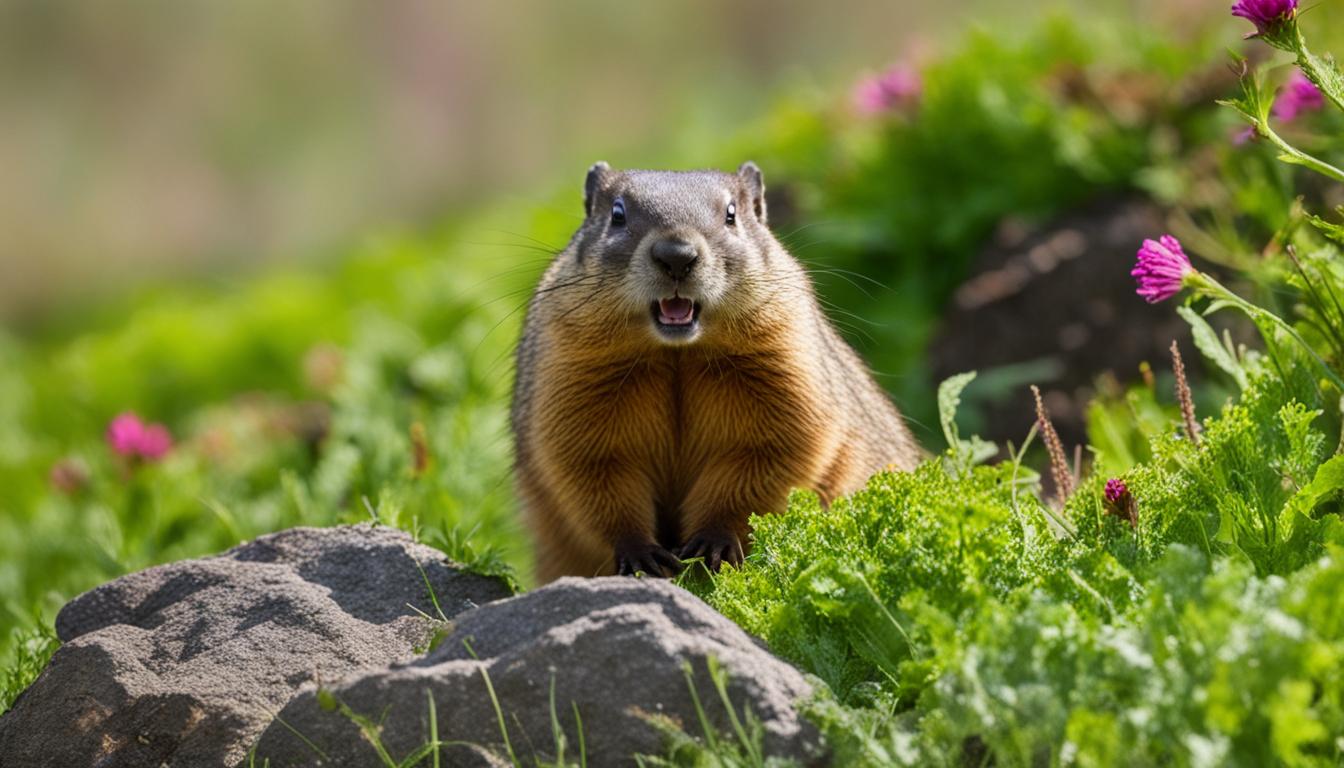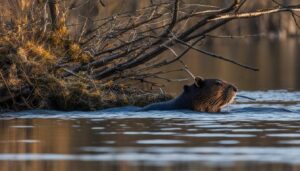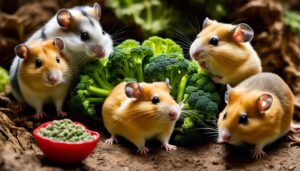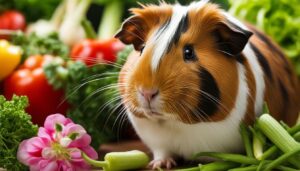Have you ever wondered if groundhogs eat lettuce? Well, you’ve come to the right place to find out! Groundhogs, those furry creatures that capture our attention every Groundhog Day, are primarily herbivores. But do they have a taste for lettuce? Let’s delve into their feeding habits and uncover the truth!
Key Takeaways:
- Groundhogs are primarily herbivores, but they do occasionally consume insects and worms.
- Lettuce is one of the greens that groundhogs enjoy eating.
- They have a varied diet that includes other plant-based foods and fruits.
- Understanding groundhog feeding habits can help manage their presence.
- Let’s appreciate these fascinating creatures and their role in the ecosystem!
The Importance of Lettuce in a Groundhog’s Diet
Lettuce plays a significant role in a groundhog’s diet, serving as a preferred food source for these herbivorous creatures. Groundhogs are naturally attracted to lettuce greens and can often be found feasting on the leaves. This leafy vegetable provides essential nutrients and hydration, contributing to the overall well-being of groundhogs. It satisfies their herbivorous nature and helps maintain their health.
Groundhogs, also known as woodchucks, have a varied diet that includes a range of plant-based foods. Lettuce is among their favorite greens, along with other vegetation like alfalfa, clovers, dandelions, and more. They also consume a variety of vegetables such as carrots, celery, corn, peas, and beans, as well as fruits like berries, cherries, and apples. However, lettuce holds a special place in a groundhog’s diet due to its availability and nutritional value.
As herbivores, groundhogs rely on a diverse array of plant matter to meet their dietary needs. Lettuce offers important vitamins and minerals that contribute to their overall health and vitality. It provides a source of hydration and helps ensure proper digestion. The inclusion of lettuce in their diet supports their overall well-being and satisfies their natural preference for leafy greens. So, if you ever come across a groundhog munching on lettuce, you now know why it holds such importance in their diet.
| Groundhog Diet | Foods |
|---|---|
| Greens | Lettuce, alfalfa, clovers, dandelions |
| Vegetables | Carrots, celery, corn, peas, beans |
| Fruits | Berries, cherries, apples |
Groundhog Feeding Habits and Patterns
Groundhogs have distinct feeding habits that are influenced by the seasons. Understanding their feeding patterns can provide insights into their preferences and behaviors. During the spring and fall, groundhogs tend to eat during the mid-afternoon when vegetation is readily available. In the summer, they adjust their foraging behavior and typically feed in the mornings and late afternoons.
In the winter, groundhogs do not eat at all as they hibernate. They enter their burrows in late fall and emerge in February, having already lost half of their body weight. This period of hibernation allows groundhogs to conserve energy during the colder months when food sources are scarce. When they emerge, they are ready to start feeding again and replenish their energy reserves.
Groundhogs have a preference for certain foods, including lettuce. Lettuce is one of the greens that groundhogs enjoy consuming, alongside other plant-based foods. Their varied diet includes vegetables like carrots, celery, corn, peas, and beans, as well as fruits like berries, cherries, and apples. However, it is important to note that groundhogs have individual preferences, and their taste for lettuce may vary.
Groundhog Feeding Habits:
- Spring and fall: Mid-afternoon feeding
- Summer: Morning and late afternoon feeding
- Winter: No feeding during hibernation
Groundhogs are opportunistic eaters and will consume a variety of available vegetation. Their feeding habits and patterns are adapted to their natural lifecycle and the changing seasons, ensuring their survival and well-being.
| Season | Feeding Time |
|---|---|
| Spring and fall | Mid-afternoon |
| Summer | Morning and late afternoon |
| Winter | No feeding during hibernation |
Groundhog Burrowing and Property Damage
Groundhogs are skilled diggers and create complex burrow systems. These burrows can pose problems for properties, especially if they are near homes. The burrow openings can be hazardous, causing twisted ankles or broken legs if stepped on unknowingly. The burrows can also lead to water damage to foundations and can result in damage to electrical wires and irrigation systems. Professional pest control technicians can help identify and provide solutions to address groundhog burrows and prevent further property damage.
Groundhog Burrowing and Property Damage
Groundhog burrows can cause significant damage to both agricultural and residential areas. Their digging activities create openings that may not be immediately visible, posing a risk of injury to humans and animals. Additionally, these burrows can weaken building foundations, leading to structural instability. The burrows may also interfere with utility lines, such as electrical wires and irrigation systems, resulting in potential damage and costly repairs.
To address the issue of groundhog burrows and property damage, it is important to seek professional assistance. Pest control technicians have the expertise to identify active burrows, assess the extent of the damage, and provide effective solutions. These professionals can utilize humane methods to remove groundhogs and implement preventative measures to prevent further burrow formation.
| Types of Property Damage Caused by Groundhog Burrows | Impact |
|---|---|
| Tripping hazards | Groundhog burrow openings can cause injuries, such as twisted ankles or broken bones, if stepped on unknowingly. |
| Foundation damage | Groundhog burrowing can weaken building foundations, leading to structural instability. |
| Utility damage | Burrows may interfere with utility lines, resulting in damage to electrical wires and irrigation systems. |
| Water damage | Groundhog burrows can accumulate water, leading to potential water damage to foundations. |
By addressing groundhog burrows and taking preventive measures, property owners can ensure the safety of their premises and minimize potential damage. Seeking professional assistance is crucial, as it allows for effective and humane solutions that protect both the property and the groundhog.
Groundhogs and Their Habitat
Groundhogs, also known as woodchucks, have specific habitat preferences that influence their distribution across different regions. They are primarily found in central and eastern parts of the United States, as well as in portions of Alaska and Canada. Groundhogs thrive in transitional areas where woodlands meet open fields or meadows, as these provide a diverse food source and suitable living conditions.
When it comes to their living arrangements, groundhogs spend the majority of their time underground in burrows that they dig in well-drained soil. These burrows are typically located near cover such as fencerows, hedgerows, or trees, which offer protection and camouflage. Their burrow systems can be quite complex, with multiple entrances, chambers for sleeping and raising young, as well as separate chambers for storing food and waste.
Understanding the habitat preferences of groundhogs can be helpful in identifying their presence and managing potential interactions. By recognizing their affinity for specific types of environments, we can take appropriate measures to protect our properties and prevent any unwanted damage caused by their burrowing activities.
The Groundhog’s Preferred Habitat:
| Preference | Description |
|---|---|
| Transition Areas | Groundhogs favor transitional areas where woodlands meet open fields or meadows. |
| Well-Drained Soil | They prefer burrowing in soil that is well-drained, providing suitable conditions for their underground homes. |
| Cover | Groundhogs seek cover from fencerows, hedgerows, or trees to protect themselves and their burrows. |
Groundhog Behavior and Socialization
Groundhogs have fascinating behavior patterns and socialization habits that contribute to their unique nature. As primarily solitary creatures, they prefer to live alone and establish their territories. However, they do mate and breed during specific times of the year. When it comes to their burrows, groundhogs take great pride in defending them from other groundhogs, displaying their territorial instincts.
Communication among groundhogs is essential for their survival and socialization. They use various methods to communicate with each other, such as whistling, which serves as a warning signal to other groundhogs in the vicinity. Groundhogs can also work together to build complex burrow systems, showcasing their cooperative behavior when it comes to creating their underground homes.
Groundhogs are diurnal creatures, meaning they are most active during the early morning and early evening hours. They rely on their sharp hearing and keen sense of smell to navigate their surroundings and forage for food. These senses help them detect approaching danger and maintain a safe distance. With their remarkable behavior and social dynamics, groundhogs continue to intrigue us with their unique traits.
Groundhog Behavior and Socialization:
| Behavior | Socialization |
|---|---|
| Solitary creatures | Establish territories |
| Mating and breeding during specific times | Defend burrows from other groundhogs |
| Communication through whistling | Cooperative behavior in burrow construction |
| Diurnal and active during specific hours | Rely on sharp hearing and keen sense of smell |
As we delve into the world of groundhogs, their behavior and socialization shed light on their fascinating nature and the importance of understanding their habits to coexist harmoniously. By gaining insights into their behavior, we can appreciate their role in the ecosystem and take appropriate measures to manage their presence effectively.
Groundhog Damage and Prevention
Groundhog burrowing can cause significant damage to both agricultural and residential areas. Their complex burrow systems can weaken building foundations, leading to structural issues and potential safety hazards. The openings of groundhog burrows can also pose a risk of injury to humans and animals, as they can be hidden and difficult to spot. Additionally, groundhogs have an appetite for crops and vegetation, which can result in financial losses for farmers.
To prevent groundhog damage, there are several proactive measures that can be taken. One effective method is to install barriers around vulnerable areas, such as gardens or structures, to physically deter groundhogs from accessing them. This can involve burying a mesh barrier several feet deep to prevent digging. Additionally, using repellents that are specifically designed to deter groundhogs can be an effective deterrent. These repellents often utilize strong smells or tastes that groundhogs find unpleasant, making them less likely to target the area.
In cases where groundhog damage is already a concern, seeking professional assistance is recommended. Pest control technicians have the expertise to identify groundhog burrows and develop appropriate solutions for managing the population. They can safely remove groundhogs from the area and implement preventive strategies to minimize further damage. Ultimately, early intervention and proactive prevention measures are key to mitigating groundhog damage and preserving the integrity of properties.
Table: Groundhog Damage Prevention Methods
| Method | Description |
|---|---|
| Installing Barriers | Physically blocking groundhog access to vulnerable areas by burying mesh barriers or erecting fences |
| Using Repellents | Applying repellents with strong smells or tastes to deter groundhogs from targeting specific areas |
| Seeking Professional Assistance | Consulting with pest control technicians who can identify groundhog burrows and implement effective management strategies |
Fun Facts about Groundhogs
Groundhogs, also known as woodchucks, whistle-pigs, and land-beavers, are fascinating creatures with some interesting characteristics. Let’s uncover some fun facts about groundhogs that you may not know!
1. Skilled Climbers and Swimmers
Contrary to popular belief, groundhogs are not limited to ground-dwelling. They are skilled climbers and can scale trees if needed. Additionally, groundhogs are capable swimmers and can adeptly navigate through water bodies. Their climbing and swimming abilities contribute to their survival skills and enable them to escape from predators.
2. Diurnal Creatures
Groundhogs are diurnal animals, meaning they are most active during the day. They are early risers and tend to forage for food in the early morning and late evening hours. This daytime activity allows them to maximize their feeding time and gather the necessary resources for their well-being.
3. Ecosystem Engineers
Groundhogs play an essential role in their ecosystem as ecosystem engineers. Their burrowing activities not only provide them with shelter and protection but also contribute to soil health. The complex burrow systems created by groundhogs help aerate the soil and enhance its fertility. These burrows also provide refuge for other wildlife, such as rabbits, foxes, and reptiles.
| Fun Fact | Details |
|---|---|
| Species Name | Woodchucks (Marmota monax) |
| Average Lifespan | 6-8 years in the wild |
| Habitat | Central and eastern parts of the United States, Alaska, and Canada |
| Diet | Primarily herbivorous, consuming greens, fruits, and vegetables |
| Hibernation | Groundhogs hibernate during winter, reducing their body temperature and heart rate to conserve energy |
Groundhogs are truly fascinating creatures with unique behaviors and adaptations. Understanding their fun facts adds to our appreciation of their role in the ecosystem and the natural world.
Conclusion
In conclusion, groundhogs are fascinating creatures that play a vital role in their ecosystem. As primarily herbivores, groundhogs include lettuce as part of their varied diet. Lettuce is an important food source for these animals, providing essential nutrients and hydration that contribute to their overall health.
Understanding groundhog feeding habits and patterns, as well as their burrowing behavior, is key to managing their presence and preventing property damage. Groundhog burrows can pose risks to humans and animals, and can also result in damage to foundations, electrical wires, and irrigation systems. By taking preventive measures such as installing barriers, using repellents, and seeking professional assistance, we can effectively prevent and manage groundhog damage.
Groundhogs are found in central and eastern parts of the United States, as well as in parts of Alaska and Canada. They prefer transitional areas where woodlands meet open fields or meadows and spend most of their time underground in complex burrow systems. These burrows are typically located near cover such as fencerows, hedgerows, or trees.
Overall, groundhogs are important inhabitants of our environment. By gaining a deeper understanding of their behavior and implementing preventive measures, we can coexist with these remarkable animals and ensure the well-being of both our properties and their natural habitats.
FAQ
Do groundhogs eat lettuce?
Yes, groundhogs do eat lettuce as part of their diet. Lettuce is a preferred food for groundhogs and plays a significant role in their overall nutrition.
What other foods do groundhogs eat?
Groundhogs primarily feed on plant-based foods such as alfalfa, clovers, dandelions, carrots, celery, corn, peas, beans, berries, cherries, and apples. They occasionally consume insects and worms as well.
How often do groundhogs eat during the year?
Groundhogs have different feeding patterns throughout the year. They eat during the mid-afternoon in spring and fall, in the mornings and late afternoons in summer, and do not eat at all during winter hibernation.
Where are groundhogs found?
Groundhogs are primarily found in central and eastern parts of the United States, as well as in parts of Alaska and Canada. They prefer transitional areas where woodlands meet open fields or meadows.
Do groundhogs live in groups?
Groundhogs are primarily solitary animals, although they do mate and breed. They defend their burrows and communicate through whistling.
Can groundhog burrows cause property damage?
Yes, groundhog burrows can pose problems for properties. They can lead to twisted ankles, broken legs, water damage to foundations, and damage to electrical wires and irrigation systems. It’s important to address groundhog burrows to prevent further damage.
What can be done to prevent groundhog damage?
Preventive measures like installing barriers, using repellents, and seeking professional assistance can help prevent and manage groundhog damage. Taking early action is key to minimizing the impact on agricultural and residential areas.
What are some fun facts about groundhogs?
Groundhogs are the largest species in the squirrel family and are known by various names like woodchucks, whistle-pigs, and land-beavers. They are skilled climbers and swimmers and play an important role in their ecosystem by maintaining soil health.




